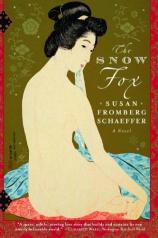Reading Group Guide
Discussion Questions
The Snow Fox

1. The structure of a novel --- the events and characters --- is the narrative plot. But there is also an emotional or intellectual "plot" in an imaginative work. What does the world of The Snow Fox say about the world in which its people live? What is the view of this world meant to communicate to the reader? Are there truths evident in that world that also rule the lives of people existing today? If so, which ones?
2. Matsuhito goes across a stream in search of persimmons, but on his way to pluck the fruit, he finds a box buried in the river. In the box are three things. What are the contents of this box meant to represent?
3. The Snow Fox begins with the story of the four children. Why is this important to the novel? Does this story have any importance in understanding what follows?
4. Lord Norimasa is, at times, very brutal. What motivates him? Is he an entirely savage person?
5. When Matsuhito and Lady Utsu meet, they do not recognize each other for some time. They have both aged, but is there another motive that explains their unwillingness to recognize each other? If so, what is it?
6. What significance do the two foxes have in this work?
7. Small narrative events often give a reader an opportunity to understand the major themes of a novel. Why does Susan Fromberg Schaeffer have Matushito discover the man in the cave? Is what he finds there important? The same question can be asked of Matsuhito's encounter with the eta or his encounter with the starving man in the old woman's hut. Why are these events important?
8. Some readers wished for a happier ending for this novel. Would you have preferred one or does the ending feel right?
9. If, at the end of their lives, Lady Utsu and Matsuhito had been asked whether they had led successful lives, what do you think they would have said?
10. A novel often has images that recur until they become themes. In The Snow Fox, one such image is fire. Another is snow. Are the two themes linked? Are there other such recurring images that build into themes?
11. Several authors have complained that many historical novels borrow a setting from the past, but have their characters behave as if they had contemporary concerns and customs. Do you find that a problem? How does The Snow Fox work toward or against this issue?
12. The events of The Snow Fox take place over eight hundred years ago when customs were very different and people's views of the world were very dissimilar. When you read a historical novel, do you hope to acquire information about another era or do you also read such a novel expecting to illuminate your own life, different as it may be? Did reading The Snow Fox cast any such light on your own view of the world?
13. Do you think that Schaeffer believes that there is such a thing as happiness? How do you think she would define happiness? If you think that she does not believe happiness exists, what in the novel shows that happiness cannot last?
The Snow Fox
- Publication Date: February 17, 2005
- Paperback: 438 pages
- Publisher: W. W. Norton & Company
- ISBN-10: 0393326527
- ISBN-13: 9780393326529







